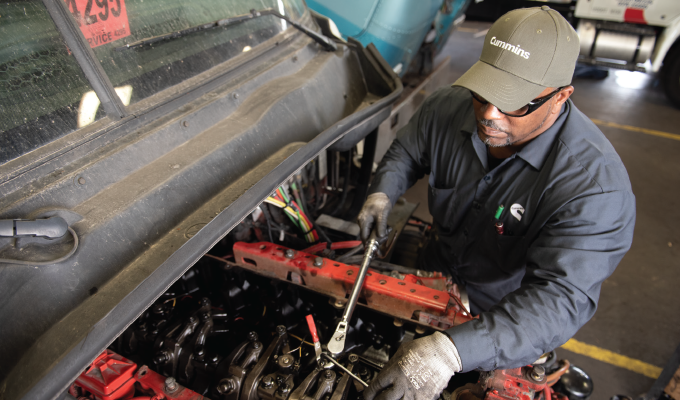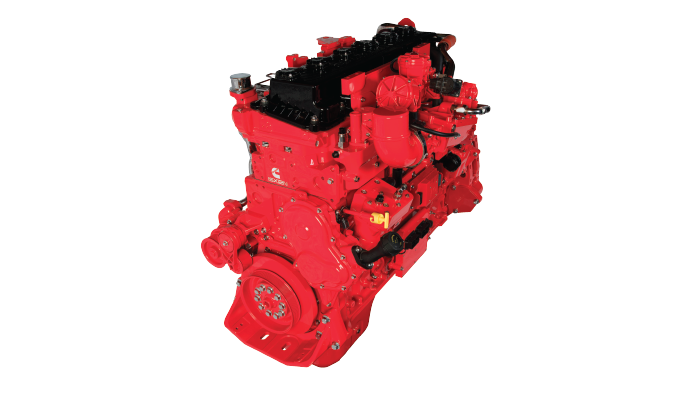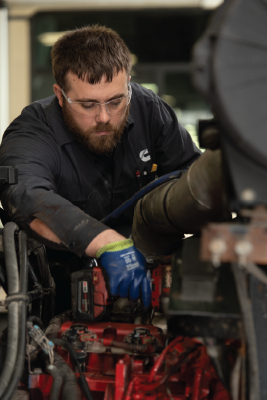Cummins isn’t quite a household name all over the world, but we would bet that almost all truck enthusiasts know the name. It’s a respected brand of diesel engines, and many of the work truck industry’s hardest working trucks are powered by a Cummins.
Yet, for some truck enthusiasts (especially in the light-duty segment) and very unlike Cummins, a power take-off (PTO) is a foreign concept. However, depending on the application, many in the work truck industry use a PTO in daily operations. A PTO is a device that transfers a truck’s mechanical power to another piece of equipment: Think dump truck or crane. If you’re unfamiliar with the concept of a PTO, you might be asking yourself “What does a PTO have to do with a Cummins engine, or any engine for that matter?” Our answer: A lot.
You see, PTOs are powered by a truck’s powertrain. Without a truck’s engine and transmission, a PTO is useless. That’s why it’s imperative that a truck owner chooses the right PTO for their job and their truck. That’s where Cummins comes in. We chatted with a Cummins expert, Russell Poling, the technical support manager for Truck Equipment Manufacturers (TEM) and Body Builders at Cummins.
Read ahead to enter into Russell’s class: Power Take-offs 101.

MWS: In order for PTOs to work correctly, they must be supported by the truck’s powertrain. How important is it for the engine, transmission, and PTO to work in harmony for maximum PTO output? Can one weak link among the three produce a weak PTO output?
POLING: It’s quite important that the engine, transmission, and PTO work in harmony in order to get the amount of power needed to operate the PTO device without causing any damage to the powertrain or the PTO pump itself. One weak link can reduce power output or efficiency, or even lead to component damage.
MWS: Fuel savings is a big concern for fleets. How does Cummins work with PTO manufacturers to ensure fuel savings while also delivering ample power for the job?
POLING: We recommend appropriate engine ratings to where customers can get the most possible power at the lowest engine speed, which is how they’ll save fuel. The slower the engine spins, the less fuel it takes.
MWS: What—if anything—do owners and upfitters need to know about a truck’s engine before installing a PTO?
POLING: It’s imperative to know whether the engine has enough horsepower and torque to operate the PTO device. You also need to know whether the engine can accept the installation of a particular device. For example, not every engine can handle REPTO (Rear Engine PTO) or the pump is handled differently.
MWS: What should one know about a truck’s transmission before installing a PTO?
POLING: If the PTO is transmission-mounted, you need to know whether the transmission has mounting capabilities for that particular PTO device. Most transmissions have a cover plate on either side; one with six bolts and one with eight bolts. The PTO can be mounted there. However, not all have this cover plate.
MWS: How does an owner decide what PTO is best for their truck and their application?
POLING: First they need the answers to a couple questions. For example, can the PTO handle the horsepower and torque requirements? Can it handle the speed it will run? Some PTO pumps are speed sensitive, so that should be a consideration.
MWS: What is a common PTO and transmission pairing with a Cummins engine?
POLING: A common PTO and transmission pairing for Cummins is a transmission-mounted six- or eight-bolt hydraulic pump with an L9, X12, L9N, and ISX12N engine. We see these most commonly on refuse trucks, dump trucks, and concrete mixers.
MWS: What are the differences in operations with a PTO with an automatic transmission versus a manual transmission?
POLING: Automatic transmission software must be programmed in order to operate with the PTO device whereas a manual transmission does not require that. Also, an automatic transmission must know when to engage or disengage the pump, so it requires some kind of an input. With manual transmissions, the pump runs all the time.
MWS: What Cummins engine/transmission/PTO combination would you suggest for different, common applications?
POLING: For refuse and dump trucks, we recommend L9, L9N, X12, and ISX12N engines with a transmission side-mounted hydraulic pump. Another common application is concrete mixers. In this case, we recommend L9 or X12 engines with REPTO. For concrete pumps and vacuum trucks, we recommend L9, L9N, X12, ISX12N, and X15 engines with a transmission-driven PTO (uses a transfer case to drive the PTO).
FOR MORE INFORMATION
Russell Poling is the technical support manager for Truck Equipment Manufacturers (TEM) and Body Builders. Reach him at TEM@cummins.com.





